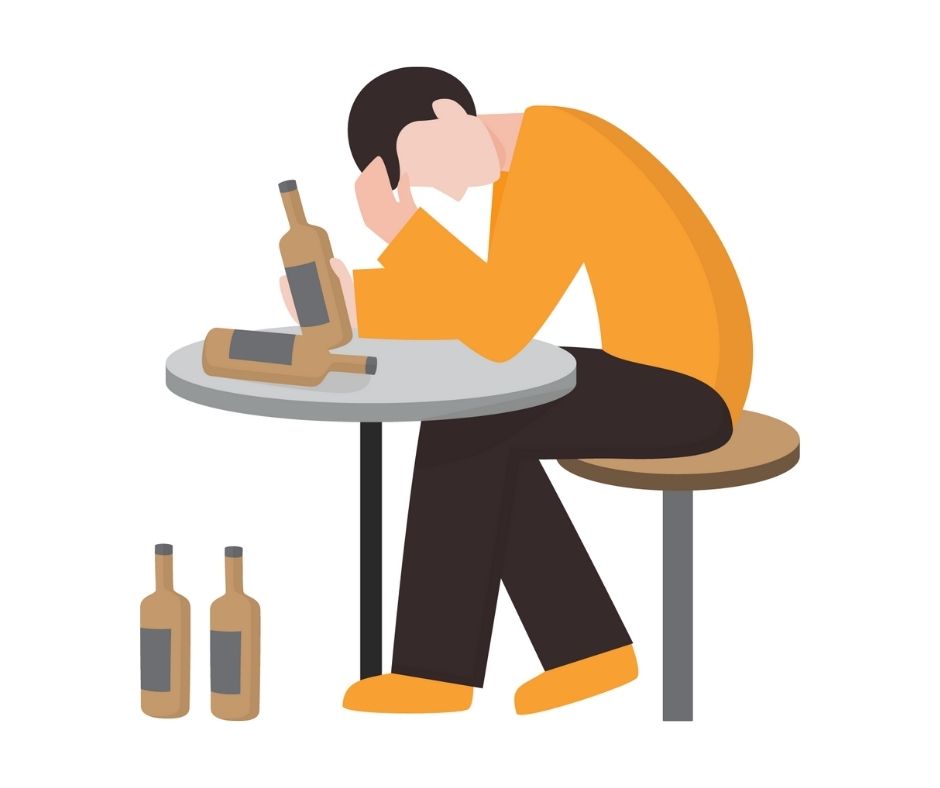Alcohol
Marijuana is made from dried leaves and flowers, and hashish is made from the plant’s hardened resin. Cannabinoids are a group of over 113 chemical substances found in cannabis. Chemical substances derived from cannabis include delta-9-tetrahydrocannabinol (THC) that is responsible for psychoactive effects, and cannabidiol (CBD) which on the other hand, do not produce any high.


Preparation:
| Preparation of Alcohol | Concentration of alcohol by volume (%ABV) | Absolute Alcohol (gms/100ml) | Standard Drink (ml) |
| Beer (standard) | 3-4 | 2.3-3.1 | 300-400 ml |
| Beer (strong) | 8-11 | 6.2-8.6 | 100-150 ml |
| Wines | 5-13 | 3.9-10.1 | 100-250 ml |
| Fortified Wines | 14-20 | 10.9-15.9 | 60-90 ml |
| Spirits (whiskey, Rum, Gin, Vodka, Brandy, etc.) | 4 | 3-1.2 | 30 ml |
| Arrack | 3 | 2-5.7 | 40 ml |
Pattern of use
- According to the frequency of drinking (over the preceding 6 months) and amount of alcohol consumed, the drinking pattern was divided into three categories:
- Continuous drinkers are those who consume alcohol daily (nearly) without binges.
- Heavy drinkers = regular alcohol drinking (more than three days per week) and frequent intoxication (more than once per week).
- Episodic drinkers = less frequent, irregular alcohol usage, longer sober periods (> 5 days), and occasional binges (less than one per week).
Alcohol Use Triggers
- There could be various triggers to the use of alcohol, mostly categorized into
- Social – Social triggers can include time spent with a former drug dealer, the person one used to drink with, or an ex-girlfriend or boyfriend who can trigger the craving for alcohol.
- Emotional – Emotional triggers such as intense feelings of happiness, anger, despair, tiredness, or stress can all lead to substance misuse.
- Environmental – The examples of environmental triggers could be driving by the site of a traumatic occurrence, visiting a party with drugs and alcohol, or seeing a display of wine glasses in a retail store are all examples of environmental triggers.
Effects of Alcohol:
Use levels:
Psychoactive substance use can be classified into two categories based on the amount consumed and the consequences:
- Social use, which includes experimentation, group activity, dietary practice, and religious ritual.
- Pathological use, Susceptible people progress to abuse and overdependence once they’ve been begun. Abuse and dependence are pathological behaviors characterized by yearning, compulsive use, tolerance, and withdrawal syndrome.
- Patterns of usage: Includes administration routes, quantity, and frequency of use, administration route, and preparation changes.
- Individual factors: Aside from the differences between naive and experienced users, there are also disparities between naive and experienced users. The occurrences of psychotic reactions are due to a hereditary vulnerability. It’s also crucial to have a mental framework and expectations.
- Social factors: Group influence, social ambiance, and shared values all have a significant impact on the content and degree of the subjective experience.
Summary of acute effects of alcohol
| Psychological Effect | Physical Effects |
| Drowsiness | Flushed faces |
| Impaired attention | Rapid pulse |
| Impaired memory | Headache |
| Mood lability (rapid changes) | Stomach ache |
| Impulsive behavior | Diarrhoea |
| Aggressive behavior | Slurred speech |
| Impaired judgment | Motor in coordination |
| Inappropriate social conduct | Nystagmus |
| Impaired occupational performance | Unsteady gait |
| Stupor/Coma | Respiratory depression |
Psychological Effects:
Alcohol’s effects start roughly 15 minutes after consumption and linger for several hours. Alcohol is a central nervous system depressant (CNS). It calms and relaxes people in modest doses. Surprisingly, it can also create the impression of power and lead to noisy behaviour.
These ‘drunkenness’ effects are mistakenly thought to be distinct from the impact of other CNS-depressing sedatives. The euphoria that might accompany drinking is a symptom of CNS depression, not stimulation. Alcohol is usually consumed as a social drug rather than as a hypnotic.
The behavioral manifestations of alcohol-induced CNS depression differ depending on the person and the situation.
- It elevates one’s mood, whether sad or happy, before ingestion.
- Alcohol impairs judgment by diminishing conscious self-control throughout intoxication, despite being acceptable and widely accepted as a social or recreational substance (relieves anxiety and increases social behaviour). Due to a lack of understanding of the impairment, the individual engages in potentially dangerous tasks such as driving automobiles and operating machinery, as well as engaging in social transgressions such as hazardous driving.
- Impairment of real or simulated driving performance provides widely accepted criteria for defining drunken driving blood alcohol concentrations of 80mg/dl or higher. The majority of people achieve this after drinking three or more 30 ml (1-0z) whiskies within an hour.
- The unpleasant effects of drinking out, especially the morning after, are at least partly a symptom of withdrawal. For example, after consuming alcohol, the first half of a night’s sleep may be deeper than usual, but this is followed by a disrupted sleep pattern indicative of greater excitability. Other elements that contribute to a hangover include staying awake late at night, unusual activity, worry, and remorse, as well as certain trace components in the alcohol.
- Throbbing headaches, vertigo, tremors, weakness, exhaustion, gastritis with nausea and vomiting, and dehydration with prolonged acidosis and labile blood pressure are all symptoms of a hangover. Although it is self-limiting and can be treated with fluids, aspirin, antacids, and sodium bicarbonate may be used to treat genetically determined early symptoms.
The acute effects that commonly occur at increasing blood alcohol concentrations (BAC):
| BAC mg/dl | Effects |
| < 80 | Euphoria, feeling of relaxation, and talking freely clumsy movements of hands and legs reduced alertness but believe himself to be alert |
| >80 | Noisy moody impaired judgement impaired driving ability |
| 100-200 | Electroencephalographic changes to begin to appear. Blurred vision unsteady gait gross motor in-coordination slurred speech aggressive, quarrelsome talking loud |
| 200-300 | Amnesia for the experience blackout |
| 300-350 | Coma |
| 355-600 | May cause or contribute to death |
Physical effects:
- Effects on the gastrointestinal tract When consumed in moderation, alcohol acts as an appetiser, increasing gastric acid output.
- Patients with the acid peptic disease should avoid alcohol since it irritates the gastric mucosa.
- Even in the presence of food, ingesting concentrated alcohol causes gastritis and hyperemia, which may make people with alcohol dependence more sensitive to dopamine transmission and contribute to early relapse after alcohol abstinence.







